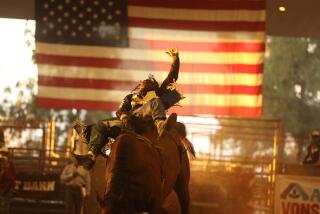Labor of Love in Old Town : Old West Back in Saddle at the Cowboy Museum
The days of the big cattle drives ended with the advent of the barbed wire fence, but the romance of the trail has left its mark on Roy Wilson, a 69-year-old cowpoke who started the Cowboy Museum in Old Town.
Wilson is trying to keep the memory of the Old West alive through his carefully crafted dioramas--three-dimensional scenes with rounded backdrops to add a sense of depth--that serve as the centerpieces for his self-styled museum at 2543 Congress St.
The museum is a labor of love for Wilson, and the San Diego public school district has included it on its regular tour of historical Old Town for fourth-graders. Last year, Wilson entertained about 60 students a day by giving lectures on the Old West while the children gazed at his art work.
“The kids love to go to the Cowboy Museum,” said Susan Wachowiak, a teacher. “They like the pictures and Mr. Wilson. He’s always so pleasant, and he tells of the days when he was a cowboy.”
Although Wilson was born too late to enjoy the golden age of the cowboys, he spent his youth on a ranch in Huerfano Creek, Colo., riding with the ranch hands as they traveled the hills to round up 300 to 400 head of cattle for branding. When he wasn’t riding, he spent much of his time reading about the Old West, his fascination with the era unfolding with every book.
“I like our whole history,’ he said, “but I seem to be more at home with the West. I had never been east of the Missouri (River).”
After riding a day with the ranch hands, Wilson recalled, he would sit with the men around a fire and everyone would pull out their pocket knives to cut tobacco and whittle. The young Wilson would mimic the men by scraping one finger against the other.
“My grandfather saw what I was doing so he bought me a knife,” Wilson said.
His whittling career begun, Wilson graduated to more artistic pursuits, and now his work includes the ornate dioramas, carved from pine, in his museum. Each one of the scenes measures about 3 feet long and 1 1/2 feet high.
The series of scenes begins with Indians leading the conquistadors to the open range, followed by another that depicts Mexican cowboys, or vaqueros , chasing cattle. A third shows a cowboy herding cows during a long drive.
One diorama shows cowboys trying to break a wild horse. One man is pulling on the horse’s tether, while another is saddling the bucking animal. There is a grim expression on the face of the wooden figurine trying to break the horse, while those outside the corral look as though they are rooting for the busy cowhand.
The outfits of the cowboys are painted in oil and accessories of holsters, lassos, guns and hats are never left out.
Wilson is currently working on a diorama that will show the Abilene, Tex., Stockyard, the place associated with the beginning of the “heyday” of the cowboy era in 1866. The figurines in the diorama are using cattle prods to move the cattle up a platform onto a railroad car.
After Wilson finishes the Abilene scene, he will begin work on the “End of the Trail,” which will be set in a saloon. “All the fun and excitement was there for them (the cowboys) as long as they had money,” Wilson said.
And finally, Wilson plans to create yet another diorama illustrating men putting up barbed wire, possibly including an old cowboy looking wistfully over the land, dreaming about the days gone by.
Could the cowboy represent Wilson himself?
“They say that was the good old days, but I think these are the good old days,” Wilson said. “It’s much more comfortable now.”
More to Read
The biggest entertainment stories
Get our big stories about Hollywood, film, television, music, arts, culture and more right in your inbox as soon as they publish.
You may occasionally receive promotional content from the Los Angeles Times.










